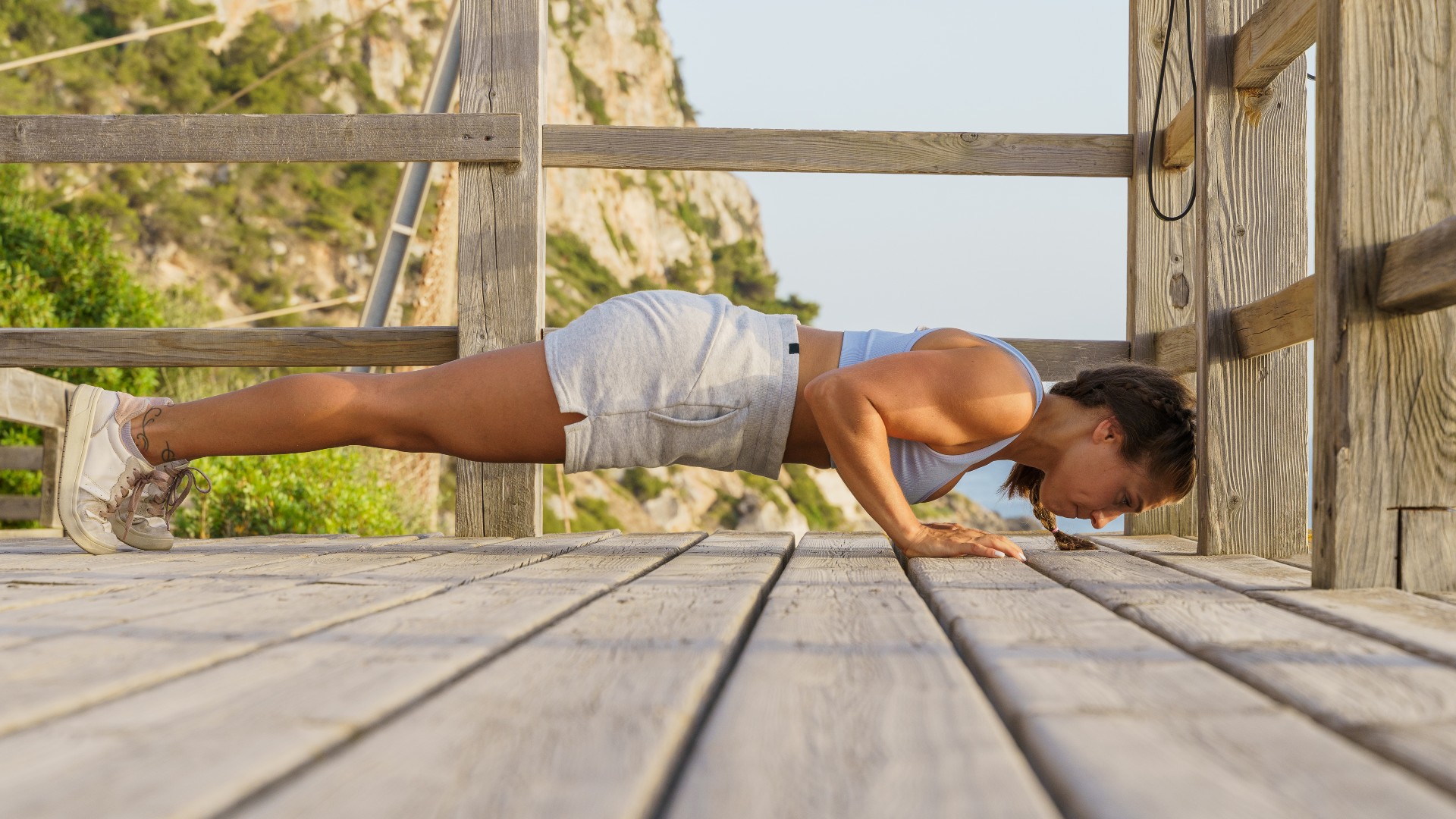
A walking push-up, side-to-side push-up, or traveling push-up (all the same exercise) is a push-up variation that hits your pecs, triceps, core and shoulders hard while you walk your hands from side to side and isolate each side of the body to increase the intensity.
I love push-ups, so this challenge appealed to me — except maybe the 100 reps. You don’t need any equipment to do it, and you can just roll out one of the best yoga mats and get pushing. Whether I’m in the gym or at home watching Netflix, I have no excuse but to get the reps in.
100 walking planks every day for seven days? Sign me up. Below, I explain how to do walking push-ups, the benefits and what happened when I committed to a week’s worth of the move. Here's my verdict.
How to do walking push-ups
You’ll find various walking push-up styles online, but here’s my approach and how to do it.
- Start in a push-up position (here’s how to do a push-up) with your hips aligned with your shoulders and core engaged
- Place a stable object (a yoga block or book lengthways or a balance trainer, for example) beneath both hands, ensuring that it won’t move
- Walk your left hand onto the floor, then bend your elbows and lower your chest to the floor
- Push the ground away to return to a high plank, then walk your left hand back to the starting position and repeat on your right side. Switch sides every rep.
I added a balance trainer for instability and to make my core muscles work harder, but you don’t need one. You could practice using the floor without elevation or any raised surface that allows you to move from the floor to an elevated position.
It's worth mentioning here that we engage in fitness challenges at Tom's Guide for a short time only to report on what, if anything, we notice. What works for my body may not work for yours, so always check with a personal trainer or medical professional before engaging in these sorts of challenges, and stop if you experience pain. For long-term progress, remember to factor in recovery and rest muscle groups to see best results.
I did 100 walking push-ups every day for a week — here are my results
Here’s what I learned from the experience.
Sign up to get the BEST of Tom's Guide direct to your inbox.
Get instant access to breaking news, the hottest reviews, great deals and helpful tips.
Day 1
The walking push-up is an advanced push-up variation that sits in the compound exercise camp, meaning it works multiple muscles. It’s commonly found during calisthenics training, which is a form of strength training, building functional strength without weights.
It requires your body to move from a high to a low position and back again as you move from side to side. As mentioned, you don’t have to elevate the body and can still perform the move using the floor, but elevation creates a deficit that increases your range of motion, working muscles harder for longer.
After just one day, my upper body felt torched, and I just knew washing my hair the next day was going to be a nightmare.
Days 2 and 3
I think the balance trainer is the most underrated piece of gym equipment. The wobbly dome creates instability, working your muscles harder, particularly the stabilizer muscles like the core and the rotator cuffs, which support your shoulder joints during movement. Coupled with supporting your bodyweight as you move one hand at a time, the humble bodyweight push-up gets a facelift.
Days two and three were interesting — 100 reps down, and suddenly, the DOMS were firing on all cylinders. I created some structure for the next few days using an EMOM — every minute on the minute. To do this, I gave myself a target of 12 reps per minute, resting for the remainder and starting my next set on the next minute, adjusting the last few rounds to suit the rep total. Accountability and intensity — check.
Days 4 and 5
I was surprised by just how fired up my core became. As I elevated my left hand, the intensity on the left side of my body increased almost double, and the same when switching sides; this isolation helped me drill into my chest, shoulders and arms without using any weights. On these days, I also happened to be at home, so switched out the balance trainer for a yoga block set lengthways instead.
Day 6
Unilateral exercises are brilliant for independently strengthening both sides of your body and working on any weaker areas. Technically, both sides are still recruiting together, but the deficit helps emphasize one side of the body at a time. By day six, my left side felt considerably harder worked and fatigued than my right — I’m right-side dominant, so it makes sense.
By this point, I was ready to mix up my training routine again.
Day 7
Finally, the last reps arrive. When performing high reps like this every day, it’s crucial to keep exercise form tight. Push-ups form part of my resistance training programs regularly, so although the rep count felt high, it wasn’t a massive stretch. That said, if you’re new to push-ups, I don’t advise jumping (or pushing) straight into 100 reps.
When elevating the push-up, the hips might lift toward the ceiling, drop toward the floor, or swing from side to side — or a combination of all three. I was sure to keep my stomach gently activated and my shoulders positioned over my hands at all times; this should help anyone avoid hurting the lower back while keeping the hips aligned with the shoulders without swinging.
I did 100 walking push-ups every day for a week — here’s my verdict
Brutal on my arms, taxing on my upper body, engaging for my core muscles — a 700-rep challenge ticked off in one week.
After seven straight days, I’m ready to park the push-up and recover. I don’t look like Alan Ritchson's Reacher just yet, of course. Building muscle takes months, not a week and you won't transform your body without the help of a consistent routine and diet plan. But my upper body feels strong.
I paired the 100 walking push-ups with my regular CrossFit routine, including full-body strength and skill work. Still, you could dial back on other upper body exercises to avoid overtraining if you don’t do many upper body workouts. I just wonder how my yoga practice will fare this week after hammering my shoulders.
More from Tom's Guide

Sam Hopes is a level 3 qualified trainer, level 2 reiki practitioner and senior fitness writer at Tom's Guide. She is also currently undertaking her Yoga For Athletes training course. Sam has written for various fitness brands and websites over the years and has experience across brands at Future such as Live Science, Fit&Well, Coach, and T3.
Having worked with fitness studios like F45 and Virgin Active, Sam now primarily teaches outdoor bootcamps, bodyweight, calisthenics and kettlebells. She also coaches mobility and stretching-focused classes several times a week and believes that true strength comes from a holistic approach to training your body.
Sam has completed two mixed doubles Hyrox competitions in London and the Netherlands and finished her first doubles attempt in 1:11.
-
Scubasteve08 These articles do an incredible disservice to readers, especially those that are newer to fitness. Doing the same exercise every day of the week is antithetical to exercise recovery and can and will get someone hurt.Reply
Not to mention is the least effective way to produce results.
